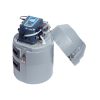Hach IO9000 I/O Modules
Features
- Digital outputs can be used to indicate an alarm or an event
- Analog 0/4-20 mA outputs can be used to send information to a SCADA system
- Analog 0/4-20mA inputs can be used to interface third party sensors to the AS950
- Free ground shipping
- Expedited repair and warranty service
- Lifetime technical support
- More
Maximum Versatility
The IO9000 module allows the use of analog inputs and outputs with the AS950 sampler. With the IO9000 module, the AS950 provides more input and output options than any other Hach sampler before it. For added versatility the IO9000 is available in two versions; IO9001 is available for simple applications that only require 1 high voltage relay while the IO9004 is fully loaded. See specifications for more detail.
Outputs
Analog 0/4-20 mA outputs can be used to send information to a SCADA system for parameters such as level, velocity, flow and pH. Examples of alarms and events include: sensor outside of limits (flow related, water quality related, internal temperature or ambient temperature), program started, program completed, sample being taken, bottle full (single bottle), pump running forward, pump running in reverse, pump error, distributor error, power failure, or main battery low.
Inputs
Analog 0/4-20mA inputs can be used to interface third party sensors to the AS950. Once logged, the analog process measurement can be used like a Hach sensor in applications such as setpoint alarms or event-based sampling. In addition, the third party measurements can be monitored on the user interface along with Hach sensors and peripherals.
Relays
Like the digital outputs, these relay outputs are used to indicate alarms or events. The difference is that relays can be used for switching AC mains line voltage to control higher power functions. Examples for use are for a warning light or sound signal, switching a diversion valve or gate or a control signal to another machine.
In The News
Monitoring Aquatic Ecosystems: How Science Drives Waterway Management in Northwest Georgia
The University of Georgia is home to multiple labs that focus on monitoring aquatic ecosystems and organisms across the state. The River Basin Center connects these monitoring efforts with external partners, including government agencies and NGOs, to inform management and restoration of the state’s waterways. Phillip Bumpers is a Postdoctoral Associate in the Rosemond lab and the Wenger lab at the Odum School of Ecology and an affiliate of the River Basin Center. An aquatic ecologist, Bumpers’ research focuses on quantifying how environmental variability shapes aquatic ecosystems and understanding the drivers of these trends.
Read MoreFrom Paddles to Phytoplankton: Studying Vermont’s Wildest Lakes
For six months of the year, Rachel Cray, a third-year PhD student at the Vermont Limnology Laboratory at the University of Vermont, lives between a microscope and her laptop, running data. For the other six months, she is hiking and canoeing four of Vermont’s lakes, collecting bi-weekly water samples. Cray studies algal phenology across four lakes in Vermont, US, that have low anthropogenic stress—or in other words, are very remote. Funded by the National Science Foundation Career Award to Dr. Mindy Morales, the lakes Cray researches part of the Vermont Sentinel Lakes Program, which studies 13 lakes in the area and, in turn, feeds into the Regional Monitoring Network, which operates in the Northeast and Midwest US.
Read MoreReimagining Water Filtration: How Monitoring and Science Enhance FloWater Filtration Systems
Over 50% of Americans think their tap water is unsafe , according to the Environmental Working Group (EWG). Other recent surveys have found that number to be as high as 70% of persons surveyed. Whether due to increased public awareness of water quality issues or confusion about how municipal water sources are regulated, there is a clear distrust of tap water in the United States. According to industry expert Rich Razgaitis, CEO and co-founder of the water purification company FloWater, this issue creates a damaging cycle. Razgaitis explained that the health and environmental problems associated with contaminated water aren’t the only issues. As people become increasingly aware that some tap water is unsafe, they resort to bottled water.
Read More








